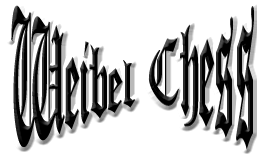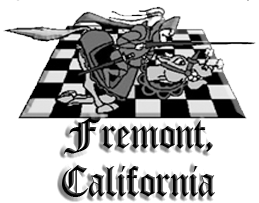


RAW BEGINNER'S CURRICULM OUTLINE
BEGINNER THROUGH INTERMEDIATE CURRICULUM OUTLINE
 |
 |
|---|---|
 |
RAW BEGINNER'S CURRICULM OUTLINE BEGINNER THROUGH INTERMEDIATE CURRICULUM OUTLINE |
DESCRIPTION: This
course is designed to teach chess to
children who have no knowledge of the game. Students will learn pawn
and piece movements as well as the fundamentals of the beginning,
the middle and the end game. Students will always touch and use
equipment. Part of the class will be board demonstrations and part practical
interaction.
RESPONSIBILITY:Students
must show respect to the instructors by paying attention and doing all assigned
tasks.
IN CLASS USE: Tournament size chess boards
and pieces for each student., Chess Notation Sheets
Chess Video Tapes, Chess learning computer programs, Worksheets
FURTHER INFO: The Success Chess website
has information about many topics including: how chess makes children smarter and specific books and CD-Roms
that will improve a students knowledge of chess:
http://www. SuccesssChess.com
Lesson 1: The Story of Chess, The Chessboard
is Your Kingdom, these are the loyal subjects,
Lesson 2: Get Ready to Play (set up
board & pieces), A Numerical Value
Lesson 3: The King! The Straight Away
Rook, The Pawn--Forward March, Rewarding Brave Pawns, Rook and Pawn Game
Lesson 4: The
Bishop--Advisor to the King & Queen, The Bishop and Pawn Game, The
Queen--Fierce and Bold, The Queen and Pawn Game,
Lesson5: The
Knight—Ready to
jump into battle, Check, Checkmate, Stalemate, Draw
Lesson 6: Castling, En Passant (very basic), Are
you ready to play a game?, How to read and write chess, A Famous Game, The
30 Rules of Chess
Lesson
7: Practice
Chess Tournment
Lesson
8: How
to read and write chess, A Famous Game,
Lesson
9: Exchange Value of Pieces (Bishop
for Knight Trade, The Exchange, Values Change with Position), Drawn or Tied
Games (perpetual check, not enough material to checkmate.
Lesson 10: Review
stalemate, 3-move repetition of position, the 50 Move Rule,
agreement), Fool's Mate, Scholar's Mate, How to use a chess clock.
Lesson 11: The 30 Rules of Chess: Opening Principles,
Endgame Principles
Lesson
12: Pins, Forks, Discovered Checks, Double Checks,
Skewers
Lesson
13: Checkmating the lone king: Checkmating
with King &
Queen, Checkmating with King & two Rooks
Lesson 14: The Endgame, Tactics, Position, Some
Openings For Children
Lesson
15: Chess
Tournament Rules: How to use a clock, Proper chess etiquette, Practice Tournament
with full USCF rules
Lesson 16: Practice
Tournament Continued, Awards & Certificates to all
RECOMMENDED AFTER COURSE: Fischer,
Margulies, Mosenfelder, Bobby Fischer Teaches
Chess, Bantam Books, $7.99 ChessMaster:
Grandmaster Edition for PC. ChessMaster 9000
for the Mac has some teaching capabilities, Chess Mentor (http://www.chess.com) about $80.
BEGINNER THROUGH INTERMEDIATE
COURSE
RESPONSIBILITY: Students should keep a folder
at home to store any handouts. Students must show respect to the instructors
by paying attention and doing all assigned tasks.
IN CLASS USE: Tournament
size chess boards and pieces for each student, Chess Notation Sheets Chess
Video Tapes, Worksheets
FURTHER INFO: The Weibel website
(http://www.WeibelChess.org) has information about many topics including: how
chess makes children smarter and specific books and CD-Roms that will improve a students knowledge.
To learn what is happening in Northern California check out http://www.CalNorthYouthChess.org and
http://www.CalChess.org
DAILY ACTIVITY: Half
the period, each day, will be spent on tactics and strategy and half on playing
chess under tournament conditions. Note: Lessons may last more than one session.
Lesson 1 Introduction! Learn what students know-administor SCS Basic Skills Test Practice, review by going
over results
Lesson 2 Continue
review: value of pieces, castling, en passant, exchange Value of Pieces (Bishop
for Knight Trade, The Exchange, Values Change with Position), Drawn or Tied
Games (perpetual check, not enough material to checkmate, forks, pins, discovered
checks, double checks, skewers, stalemate, 3-move repetition of position, the
50 Move Rule, agreement), Fool's Mate, Scholar's Mate, How to use a chess
clock
Lesson
3 Play and
record game for analysis; go over notation with opponent & discuss better
moves, mistakes, thoughts etc.
Lesson 4 A
Famous Game-COUNT ISIDORE VS. MORPHY: Strategy & Tactics in Chess (what
they mean) Positional vs Tactical players
Lesson 5 The 30 Helpful Rules of Playing Chess: Opening
Principles, Middlegame Principles, Endgame Principles: Tactics &
Strategies
Lesson 6 Checkmating
the lone king: checkmating with King & Queen, checkmating with King &
two Rooks, checkmating with King and one Rook
Lesson 7 Development:
open lines, weak squares, trapped pieces
Lesson 8 Pawn
Power in chess, Controlling squares & diagnals
RECOMMENDED
AFTER COURSE: We suggest
you obtain a copy of Dan Heismanís Everyoneís
2nd Chessbook, Lazlo Polgarís Chess, 5334 problems, Fred Wilsonís 101 Questions on How to Play Chess and
Frisco del Rosarioís A First Book of Morphy. Also, if you can still locate a copy of the
CD-Rom, Maurice Ashley Teaches Chess, it is great. For more resources go to:
http://www.
CalNorthYouthChess.org/WeibelChess/Books.html.
(Some of the things we expect students to know after graduating from our Beginner’s Programs)
________ 1. DEMONSTRATE HOW THE PAWN MOVES. P
________ 2. DEMONSTRATE HOW THE KNIGHT MOVES.N
________ 3. DEMONSTRATE HOW THE BISHOP MOVES. B
________ 4. DEMONSTRATE HOW THE QUEEN MOVES. Q
________ EXPLAIN WHY YOUR TRYING TO PLAY THE SCHOLAR’S MATE IS UGLY CHESS. (5 PTS) ________ DESCRIBE HOW YOU SHOULD START A GAME OF CHESS THAT WOULD BE CONSIDERED BEAUTIFUL CHESS.(5 PTS)
SCORE:__________
DESCRIPTION: This course is designed for students who understand the basics of chess tactics and strategy. This course will emphasize more advanced strategy, primarily time and spaces advantage in the game of chess.
RESPONSIBILITY:Students should keep a folder at home to store any handouts. Students must show respect to the instructors by paying attention and doing all assigned tasks.
IN CLASS USE: Students will be provided tournament size chess boards and pieces, Chess Notation Sheets Chess Video Tapes, Worksheets
FURTHER INFO: The Success Chess website (http://www.SuccessChess.org) has information about many topics including: how chess makes children smarter and specific books and CD-Roms that will improve a students knowledge. To learn what is happening in Nor-Cal youth chess you can go to http://www.CalNorthYouthChess.org
DAILY ACTIVITY: Half the period, each day, will be spent on tactics and strategy and half on playing chess under tournament conditions. Note: Lessons may last more than one session.
Lesson 1 Introduction! Learn what students know-administor SCS Basic Skills Test, If needed, recommend a skill level class change.
Lesson 2 Developing
Board Vision
Lesson 3 Board Vision and how it should/must be used (eg. think with your head not your hands; you can’t play what you don’t see; look what your opponent is doing;the more you are winning, the more you should think defense; an attack on the flank is best met by a counterattack in the center)
Lesson 4 Board
Vision and Time (tempo and how to achieve it)
Lesson 5 Board Vission and Space Advantages (space count and how to maximize the advantage)
Lesson 6 Asuuming the worst and assuming the best—do not
assume
Lesson 7 Avoiding
“Flip a coin and hope chess” for REAL CHESS (use 100% of the time, no: “I
can’t work hard on every move; it’s too much effort!”)
Lesson 8 Avoiding decoys and blunders
Lesson 9 Learning how to do a post-mortum (going over you games with your opponent to find your time space errors and improve your board vision)
RECOMMENDED AFTER COURSE: Robert Synder’s, Unbeatable Chess Lessons for Juniors, Graham Burgess, The Mammoth Book of Chess.L.A. Horowitz & Fred Reinfeld, How to Think Ahead in Chess. For more resources go to http://www.WeibelChess.org/Books.html.
WHO: This course is designed for students who
have experienced the pleasure of tournament chess or
have enjoyed the art of chess through extensive lessons.
DESCRIPTION:The students will be instructed in advanced chess strategy and planning. Since the instructors for this level of chess will be very
talented at the game, the course material may vary depending on who is
teaching the program. However, the basic concepts and objectives will remain
consistent.
RESPONSIBILITY: Students
must show respect to the instructors by paying attention and doing all
assigned tasks.
IN
CLASS USE: Tournament size chess boards
and pieces for each student., Chess Notation
Sheets Chess Video Tapes, Chess learning computer programs, Worksheets.
CURRICULUM:
Lesson
1: Introduction to Advanced Chess Strategy and Planning
Lesson
2: Good Knight vs. Bad Bishop
Lesson
3: Weak Dark Squares, Weak Light Squares
Lesson
4: Queenside Pawn Majority in the Endgame
Lesson5:
Attacking the King: King Hunting
Lesson
6: The Two Bishops
Lesson
7: The Exchange Sacrifice
Lesson
8: Essential Knowledge in King & Pawn Endgames
Lesson
9: Attacking the King: Focal Points Against the Castled King
Lesson
10: Passed Pawns & Blockade
Lesson
11: Essential Knowledge in Rook & Pawn Endgames
Lesson
12: Opposite-colored Bishops in the Middlegame
Lesson
13 Prophylaxis – Prevention of Counterplay
Lesson
14: Attacking the King: Classic Bishop Sacrifice & Double
Bishop
Sacrifice
RECOMMENDED AFTER
COURSE:
Reuben
Fine, Ideas Behind the Chess Openings,
Reuben
Fine, The Middle Game in Chess
Richard Reti , Masters
of The Chess Board
Chess Mentor (http://www.chess.com) about $80.